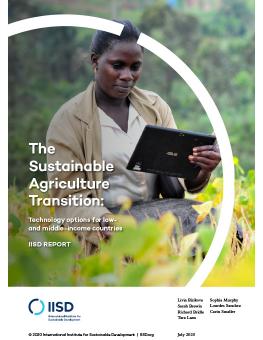
The Sustainable Agriculture Transition: Technology options for low- and middle-income countries
This report explores the ways in which disruptive technologies can help food and agriculture systems worldwide deal with three complex challenges.
First, demand for nutritious food continues to rise globally. Second, food and agriculture systems are having to adapt to changing weather and ecological conditions while reducing the harm they cause to the environment. Third, farmers and farmworkers face economic precarity and vulnerability, with too many living in poverty and chronic hunger. The challenges are immense, but there are technologies that can make a positive difference.
This report looks at innovations in three areas of technology, particularly how the declining costs and increased availability of renewable energy can make a difference. The authors also analyzed how off-grid electrification using solar photovoltaics (PV), dramatic improvements in battery capacity and performance, and the data revolution in information and communication technology (ICT) can each strengthen the resilience and sustainability of food and agriculture systems in low-and middle-income countries.
You might also be interested in
National State of the Environment Report: Uzbekistan
The National State of the Environment Report (NSoER) is a comprehensive document that provides a snapshot of current environmental trends in Uzbekistan's socio-economic development for citizens, experts, and policy-makers in the country of Uzbekistan.
WTO Agriculture Negotiations at MC13: What does the lack of outcomes mean for least developed countries and other vulnerable economies?
IISD expert Facundo Calvo analyzes what came out of the WTO's agriculture negotiations at the 13th Ministerial Conference in Abu Dhabi and its implications for least developed countries and other vulnerable economies.
Financial Benefit-Sharing Issues for Critical Minerals: Challenges and opportunities for producing countries
Exploring nuances in the key features of critical minerals and the new challenges and opportunities they present to fiscal regulation.
At WTO meet, India will have to balance between protecting local fishers and fishing sector growth
India is likely to advocate for securing the interests of its artisanal fishers while facilitating the growth of the fishing sector at the World Trade Organisation’s 13th Ministerial Conference (MC13) in Abu Dhabi later this month.